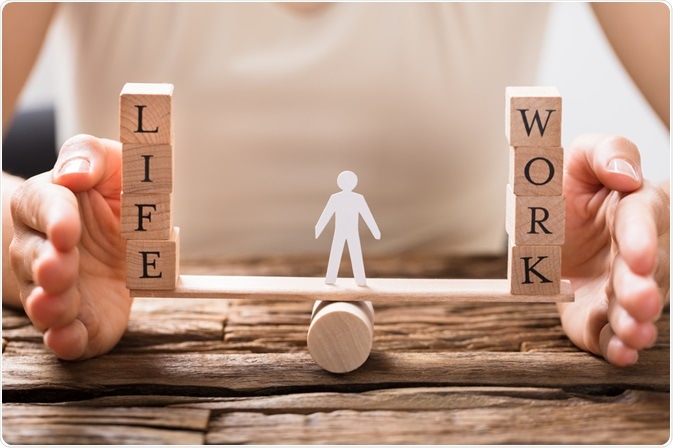Work-life balance has always been an issue once individuals began to work out of the home, without the usual level of control over their working hours or the responsibilities allotted to them at work. With the ongoing coronavirus 2019 (COVID-19) pandemic, which has caused high unemployment rates in many countries worldwide, it might seem ironic to talk of work-life balance. However, no matter how pressing the need for employment, it is essential to understand how best individuals can experience satisfaction inside and outside working hours.

Image Credit: Andrey_Popov/Shuttershock.com
Definition
This state, called work-life balance, can be defined as an individual's ability to meet their work and family commitments, as well as other non-work responsibilities and activities. Outside work hours, leisure relates to non-work activities, whereas free time by definition is not committed to any activity. The difficulty in defining work-life balance lies in the fact that all these factors play a role in determining whether the individual feels this balance has been achieved. Achieving a balance is not about giving equal time to each of these areas. Instead, it is having the ability to allocate enough time, labor, and thought so that individuals are satisfied.
Different countries seem to have alternative work ethics, with the Netherlands having the lowest percentage of employees who work long hours. Denmark, France, and Spain are also high on the list. The USA is 30th on a list of 38 countries where work-life balance is considered, with most full-time workers putting in over 8 hours of work a day. Over a tenth of Americans said they worked over 50 hours a week, and two-thirds perceiving a lack of balance.
Interestingly, research has suggested that this is a common problem amongst highly paid managers, despite control over this balance expected from individuals with this position.
Determinants of work-life balance
For most people, work commitments are a fundamental element of life satisfaction and are not performed for the wage alone. Researchers link this to the daily structure and social identity offered by professional positions and expectations to be met. The determinants of work-life balance include both factors that can be altered by the individual and those that need organizational initiative.
Some are satisfied to spend long hours at work for potential career progression, while others feel satisfied if their family is prioritized. Still, aligning both remains a focus for many. It may be that balance is best defined when it is absent. In any case, when the preferred type of balance is not achieved, it leads to interference or conflict.
Individual factors
Individuals may be affected by their attitude towards work – they may be overachievers, perfectionists, or compulsive workers, all of whom are generally seen as workaholics who spend more time than required, sacrificing other activities.Those overworked also commit to long hours even when not needed to, but are not satisfied by the returns. The worker's health status, personality type and degree of resilience, as well as the stage of career and period of life, and gender are other key parameters in determining a work-life balance.
Organizational factors
Organizational measures influencing work-life balance involve the work demanded in terms of the time spent at work and any intensity or pressure. In addition, the organization determines the work culture. Inflexible hours, demanding managers, incompetent colleagues, and long commutes all contribute to this problem. Connectivity has worsened this problem. Remote workers are often required to be accessible to their employers, even if these interruptions occur outside of commitment hours or during time spent with family.
Home as a source of imbalance
Work itself is poorly defined, as life outside the workplace also consists of other types of work. This is true of all who operate at home- or family-based businesses but has become a unique pandemic problem. Many at home are expected to be online or available for far longer than before. When it comes to tasks done as non-paid but necessary labor, the demands of home and its culture are seen to be determinants of work-life balance. For instance, role-related expectations are important, along with the presence of dependent children or older adults. Women may be implicitly expected to take care of domestic matters after working hours. Similarly, the care of children and elderly family members may be an unspoken or accepted obligation of one working family member.
Indicators of work-life balance
Both subjective and objective indicators of work-life balance have been suggested. For instance, working parents may be satisfied with the level of balance they perceive, but their children may feel deprived of parental company. Or, perhaps, their children's teachers perceive that parental guidance and encouragement to do their homework is lacking.
In Europe, labor laws envisage no more than 48 hours a week at work, indicating that beyond this, labor is both unhealthy and relatively unproductive. The spillover of work to the home, or vice versa, are undesirable indicators of work-life imbalance. Society values play an essential role in deciding how work-life balance is perceived. If family responsibilities are not seen as crucial, or at least not as necessary as economic productivity, it is unlikely that workaholics would face any interference.
Image Credit: Jes2u.photo/Shuttershock.com
Consequences
The consequences of such imbalance may be poor satisfaction, mental stress, unproductivity, problematic behavior at work or home, which may affect either work colleagues or family members.
Even if work hours are abridged, without an accompanying reduction in work obligations, the time spent at home may be overshadowed by constant work-related thoughts and pressure. For some, stressors at work lead to job exhaustion and decreased health, potentially impacting satisfaction in personal relationships.
Chronic stress is associated with a weaker immune response, leading to more minor illnesses, muscle aches, and headaches; they are also at a higher risk of strokes and heart attacks. They are also at a higher risk of stroke and heart attacks.
Irritability and anxiety are found to be up to 75% more common in this group. Such issues may culminate into prolonged depression, sadness, and drug or alcohol abuse. Also, if organizational loyalty is stressed at the expense of family responsibilities and expectations, family satisfaction and a withdrawal from family roles may be expected.
It is important to understand how these problems are associated with lower productivity. This occurs via low employee morale, burnout, and high employee turnover. Healthcare spending is also lower among employees who are under less stress.
The benefits
With a satisfactory work-life balance, employers can reap a range of benefits. Productivity is higher, absenteeism is lower, and physical and mental health improves with a higher commitment and motivation to work. Personal relationships can also benefit from achieving this balance.
How to improve work-life balance
Critical steps in this process include identifying causes of stress and understanding whether personal sacrifices compensate for the rewards of longer work commitments.
Changes to work hours, shifting task responsibilities, and determining flexible deadlines are all actions that could be taken. Decisions such as these might be especially impactful during certain stages of life. Establishing boundaries at work, such as knowing when tasks are complete, is another option. Balance is an ongoing process. Actions might have to be repeated when stress is experienced during or outside work hours.
Organizational initiatives can make the task of maintaining a reasonable balance much easier, as when employers take family and community obligations into account. Organizations should, for instance, allow employees to unplug from work once they are out of the office so that they cannot be contacted for work purposes until they come back the next working day.
As remote work became the norm during the pandemic, efficient productivity without personal sacrifices has become evident. Workers should keep such perspectives in mind to balance work and life responsibilities.
References
- Guest, D. E. et al (2021). Perspectives on the Study of Work-life Balance. Social Science Information. http://ssi.sagepub.com/content/41/2/255.
- Online.maryville.edu (2021). Achieving Work-Life Balance: The Ultimate Guide. https://online.maryville.edu/blog/work-life-balance-guide/
- Bbc.com. (2021). Why it's wrong to look at work-life balance as an achievement. https://www.bbc.com/worklife/article/20210302-why-work-life-balance-is-not-an-achievement
Further Reading
- All Mental Health Content
- World mental health support and the effect of stigma and discrimination
- Pollution and Mental Health
- Mental Health Nursing
- Treatment Options for Intrusive Thoughts
Last Updated: Aug 6, 2021

Written by
Dr. Liji Thomas
Dr. Liji Thomas is an OB-GYN, who graduated from the Government Medical College, University of Calicut, Kerala, in 2001. Liji practiced as a full-time consultant in obstetrics/gynecology in a private hospital for a few years following her graduation. She has counseled hundreds of patients facing issues from pregnancy-related problems and infertility, and has been in charge of over 2,000 deliveries, striving always to achieve a normal delivery rather than operative.
Source: Read Full Article

